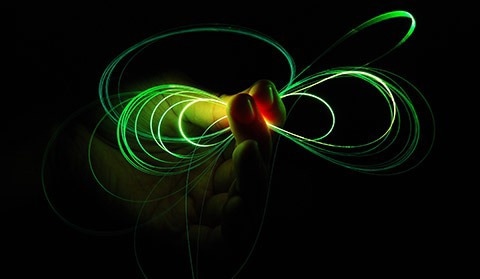At the University of Southampton, a research group has displayed that light could be moved within a distance smaller than its wavelength—a level of unparalleled accuracy.

Image Credit: University of Southampton.
Researchers from Southampton, collectively with the universities of Dortmund and Regensburg in Germany, have illustrated the fact that a beam of light can not only be restricted to a spot that is 50 times smaller compared to its wavelength but that also–in a first of its kind–the spot can be shifted by minuscule amounts at the point where the light has been confined.
The outcomes of their theoretical study are reported in the journal Optica.
One of the defining difficulties in modern photonics is confining and regulating light on ever smaller volumes. It is the science present behind the generation, detection, and manipulation of light. How tightly the light is confined identifies the limits for the observability of nanoparticles and also the intensity and accuracy of light-based devices.
One instance is optical tweezers. These are extensively utilized in laboratories throughout the world in fields like DNA research. They comprise highly focused laser beams that tend to trap, manipulate, and shift particles with fantastic accuracy.
One of the restrictions with standard optical tweezers is that lenses lack the ability to concentrate beams on lengths much smaller compared to the own wavelength of the laser beam, thereby restricting the achievable accuracy.
By its nature, light is indeed very difficult to localize on a smaller length scale than its wavelength, a critical threshold known as the Abbe limit. However, using a sophisticated model and numerical simulation, we have successfully demonstrated a novel approach to localize and dynamically manipulate light at a sub-wavelength scale.
Erika Cortese, Study author and Research Fellow, Quantum, Light and Matter Group, University of Southampton
The study collaboration was headed by Simone De Liberato.
We believe our novel approach to actively control confined electromagnetic fields could have high-impact consequences across multiple nanophotonic applications. Looking to the future, in principle, it could lead to the manipulation of micro and nanometre-sized objects, including biological particles—or perhaps the sizeable enhancement of the sensitivity resolution of microscopic sensors.
Simone De Liberato, Professor and Leader, Quantum Theory and Technology Group in the School of Physics and Astronomy, University of Southampton
The researchers believe that by performing additional research, it is possible for them to eventually set the stage for more advanced manipulation methods, like the sorting and rational assembly of nanoparticles, applied in chemistry, biology, and also soft matter research.
Journal Reference:
Cortese, E., et al. (2023) Real-space nanophotonic field manipulation using non-perturbative light–matter coupling. Optica. https://doi.org/10.1364/OPTICA.473085
Source: https://www.southampton.ac.uk/